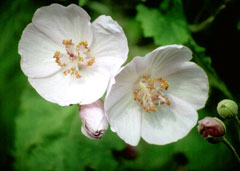
Latin Name: Abutilon vitifolium
USDA Hardiness: 7-10
Native Range: SOUTHERN AMERICA: Chile
Edibility Rating: 3 / 5
Medicinal Rating: 0 / 5
Region:
Family:
Plant Type:
Medicinal Uses
Edible Uses
Edible Parts: Flowers | Edible Uses: Flowers - raw. The flowers are up to 8cm in diameter[219]. A delicious mild flavour with a slight sweetness, they have a pleasant mucilaginous texture and can be eaten in quantity as part of a salad[K].
Cultivation
An easily grown plant, fast to establish and flower from seed and growing best in coastal areas[260]. In hot summer climates it requires partial shade, plus ample humidity and moisture in the growing season[260]. Requires a sunny position or part day shade in a fertile well-drained soil[200]. Dislikes drought[200]. Plants do not like windy conditions[260]. This species is only hardy in the mildest areas of Britain, tolerating temperatures down to between -5 to -10°c when given the protection of a south or south-west facing wall[11, 184, 200]. Plants are often deciduous in cold winters[219]. A deep mulch in winter and tying in growth to the wall will maximise protection in winter[200]. If the plant is cut back by cold weather, it will normally resprout from the base in the spring and can flower on the current year's growth[202]. A plant of the cultivar 'Album', growing in an open position at Westonbirt Arboretum, was 2 metres tall and flowering prolifically in June 1994[K]. Plants tend to be short-lived in Britain, dying suddenly without any apparent cause. This is probably because they flower so profusely that they die of exhaustion[11]. They produce an abundance of fertile seed, however, and this normally breeds true to type, whether from the white or the purple-flowered form[11]. Dead-heading plants to prevent seeding can enhance longevity[200]. Tip-prune young plants to promote a bushy habit, older plants can be cut back hard annually in spring if required[200]. There are some named forms, selected for their ornamental value[200]. 'Album' has very nice tasting flowers[K]. Plants in this genus are notably resistant to honey fungus[200].
Known Hazards
None known
Habitats
Open places in warm temperate forests[260].
